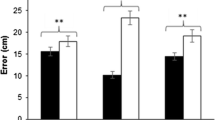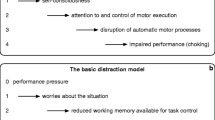Abstract
Choking under pressure describes the phenomenon of people performing well below their expected standard under circumstances where optimal performance is crucial. One of the prevailing explanations for choking is that pressure increases the conscious attention to the underlying processes of the performer's task execution, thereby disrupting what would normally be a relatively automatic process. However, research on choking has focused mainly on the influence of pressure on motor performance, typically overlooking how it might alter the way that vision is controlled when performing these motor actions. In this article we ask whether the visual component of expert motor-skill execution is susceptible to choking much like the motor component is thought to be. To do so, we draw heavily on empirical findings from studies of sporting expertise, in particular focussing on the role of gaze in three types of visually-guided actions: interceptive actions, aiming tasks, and anticipatory skill. For each of these skills we (i) evaluate the nature of the expert advantage, (ii) discuss the role of consciousness in their control, (iii) examine the potential impact of pressure on task performance, and (iv) consider interventions designed to reduce the likelihood of choking when performing these tasks.

Similar content being viewed by others
References
Abernethy, B., & Russell, D. G. (1987). The relationship between expertise and visual search strategy in a racquet sport. Human Movement Science, 6, 283–319.
Abernethy, B., Wood, J. M., & Parks, S. (1999). Can the anticipatory skills of experts be learned by novices? Research Quarterly for Exercise and Sport, 70, 313–318.
Abernethy, B., Schorer, J., Jackson, R. C., & Hagemann, N. (2012). Perceptual training methods compared: The relative efficacy of different approaches to enhancing sport-specific anticipation. Journal of Experimental Psychology: Applied, 18, 143–153.
Alder, D.B., Ford, P.R., Causer, J., Williams, A.M. (2014). Perceptual training with anxiety: effects on the anticipatory judgements of elite athletes. Meeting of the Expertise and Skill Acquisition Network, Sheffield UK.
Anderson, J. R. (1993). Rules of mind. Hillsdale: Lawrence Erlbaum Associates.
Baumeister, R. F. (1984). Choking under pressure: Self-consciousness and paradoxical effects of incentives on skillful performance. Journal of Personality and Social Psychology, 46, 610–620.
Behan, M., & Wilson, M. (2008). State anxiety and visual attention: The role of the QE period in aiming to a far target. Journal of Sports Sciences, 26, 207–215.
Beilock, S. L., & Carr, T. H. (2001). On the fragility of skilled performance: What governs choking under pressure? Journal of Experimental Psychology: General, 130, 701–725.
Beilock, S. L., Carr, T. H., MacMahon, C., & Starkes, J. L. (2002a). When paying attention becomes counterproductive: Impact of divided versus skill-focused attention on novice and experienced performance of sensorimotor skills. Journal of Experimental Psychology: Applied, 8, 6–16.
Beilock, S., Wierenga, S. A., & Carr, T. H. (2002b). Expertise, attention, and memory in sensorimotor skill execution: Impact of novel task constraints on dual-task performance and episodic memory. The Quarterly Journal of Experimental Psychology, 55A, 1211–1240.
Beilock, S. L., Bertenthal, B. I., McCoy, A. M., & Carr, T. H. (2004). Haste does not always make waste: Expertise, direction of attention, and speed versus accuracy in performing sensorimotor skills. Psychonomic Bulletin and Review, 11, 373–379.
Bootsma, R. J., & van Wieringen, P. C. W. (1990). Timing an attacking forehand drive in table tennis. Journal of Experimental Psychology: Human Perception and Performance, 16, 21–29.
Cappuccio, M. & Ilundain-Agurruza, J. (this issue). Introduction to the special issue on unreflective action and the choking effect. Phenomenology and the Cognitive Sciences.
Carr, T. (this issue). Strengths and weaknesses of reflection as a guide to action: Pressure assails performance in multiple ways. Phenomenology and the Cognitive Sciences.
Causer, J., Holmes, P. S., Smith, N. C., & Williams, A. M. (2011a). Anxiety, movement kinematics, and visual attention in elite-level performers. Emotion, 11(3), 595–602.
Causer, J., Holmes, P. S., & Williams, A. M. (2011b). Quiet eye training in a visuomotor control task. Medicine & Science in Sports & Exercise, 43, 1042–1049.
Deikman, A. J. (1966). De-automatization and the mystic experience. Psychiatry, 29, 324–338.
Deschamps, T., Nouritt, D., Caillou, N., & Delignières, D. (2004). Influence of a stressing constraint on stiffness and damping functions of a ski simulator’s platform motion. Journal of Sports Sciences, 22, 867–874.
Dicks, M., Davids, K., & Button, C. (2010). Individual differences in the visual control of intercepting a penalty kick in association football. Human Movement Science, 29, 401–411.
Dreyfus, H. L. (2002). Intelligence without representation – Merleau-Ponty’s critique of mental representation. Phenomenology and the Cognitive Sciences, 1, 367–383.
Farrow, D., & Abernethy, B. (2002). Can anticipatory skills be learned through implicit video based perceptual training? Journal of Sports Sciences, 20, 471–485.
Farrow, D., Chivers, P., Hardingham, C., & Sachse, S. (1998). The effect of video-based perceptual training on the tennis return of serve. International Journal of Sport Psychology, 23, 231–242.
Fitts, P., & Posner, M. (1967). Human performance. Belmont: Brooks-Cole.
Fuchs, A. H. (1962). The progression–regression hypothesis in perceptual-motor skill learning. Journal of Experimental Psychology, 63, 177–182.
Gibson, J. J. (1979). The ecological approach to visual perception. Boston: Houghton Mifflin.
Gottlieb, G. (this issue). Know-how, procedural knowledge, and choking under pressure. Phenomenology and the Cognitive Sciences.
Gray, R. (2004). Attending to the execution of a complex sensorimotor skill: Expertise differences, choking, and slumps. Journal of Experimental Psychology: Applied, 10, 42–54.
Hagemann, N., Strauss, B., & Cañal-Bruland, R. (2006). Training perceptual skill by orienting visual attention. Journal of Sport & Exercise Psychology, 28, 142–158.
Hardy, L., Mullen, R., & Jones, G. (1996). Knowledge and conscious control of motor actions under stress. British Journal of Psychology, 87, 621–636.
Harle, S. K., & Vickers, J. N. (2001). Training quiet eye improves accuracy in the basketball free throw. Sport Psychologist, 15, 289–305.
Jones, C. M., & Miles, T. R. (1978). Use of advance cues in predicting the flight of a lawn tennis ball. Journal of Human Movement Studies, 4, 231–235.
Koedijker, J. M., Poolton, J. M., Maxwell, J. P., Oudejans, R. R., Beek, P. J., & Masters, R. S. W. (2011). Attention and time constraints in perceptual-motor learning and performance: Instruction, analogy, and skill level. Consciousness and Cognition, 20, 245–256.
Koedijker, J. M., Kredel, R., Schindler, S., & Hossner, E.-J. (2013). Effects of vibrations on gaze behavior in high-speed navigation. Proceedings of the EuroMov Inaugural Conference, Montpellier, France.
Land, M. F., & McLeod, P. (2000). From eye movements to actions: How batsmen hit the ball. Nature Neuroscience, 3, 1340–1345.
Liao, C. H., & Masters, R. S. W. (2001). Analogy learning: A means to implicit motor learning. Journal of Sports Sciences, 19, 307–319.
Mann, D. T. Y., Williams, A. M., Ward, P., & Janelle, C. M. (2007). Perceptual-cognitive expertise in sport: A meta-analysis. Journal of Sport & Exercise Psychology, 29, 457–478.
Mann, D. L., Abernethy, B., & Farrow, D. (2010). The resilience of natural interceptive actions to refractive blur. Human Movement Science, 29, 386–400.
Mann, D. L., Spratford, W., & Abernethy, B. (2013). The head tracks and gaze predicts: How the world’s best batters hit a ball. PloS One, 8, e58289.
Masters, R. S. W. (1992). Knowledge, knerves and know-how: The role of explicit versus implicit knowledge in the breakdown of a complex motor skill under pressure. British Journal of Psychology, 83, 343–358.
Masters, R. S. W., & Maxwell, J. P. (2004). Implicit motor learning, reinvestment and movement disruption. What you don’t know won’t hurt you? In A. M. Williams & N. J. Hodges (Eds.), Skill acquisition in sport: Research, theory and practice (pp. 207–228). London: Routledge.
Masters, R. S., Maxwell, J. P., & Eves, F. F. (2009). Marginally perceptible outcome feedback, motor learning and implicit processes. Consciousness and Cognition, 18, 639–645.
Maxwell, J. P., Masters, R. S. W., Kerr, E., & Weedon, E. (2001). The implicit benefit of learning without errors. The Quarterly Journal of Experimental Psychology, 54A, 1049–1068.
Moore, L., Vine, S. J., Cooke, A., Ring, C., & Wilson, M. R. (2012). Quiet eye training expedites motor learning and aids performance under pressure: The roles of response programming and external attention. Psychophysiology, 49, 1005–1015.
Nieuwenhuys, A., & Oudejans, R. R. (2010). Effects of anxiety on handgun shooting behavior of police officers: A pilot study. Anxiety, Stress, & Coping, 23, 225–233.
Nieuwenhuys, A., Pijpers, J. R., Oudejans, R. R., & Bakker, F. C. (2008). The influence of anxiety on visual attention in climbing. Journal of Sport & Exercise Psychology, 30, 171–185.
Ryu, D., Kim, S., Abernethy, B., & Mann, D. L. (2013). Guiding attention aids the acquisition of anticipatory skill in novice soccer goalkeepers. Research Quarterly for Exercise and Sport, 84, 252–262.
Sailer, U., Flanagan, J. R., & Johansson, R. S. (2005). Eye–hand coordination during learning of a novel visuomotor task. The Journal of Neuroscience, 25, 8833–8842.
Savelsbergh, G. J. P., Williams, A. M., Van der Kamp, J., & Ward, P. (2002). Visual search, anticipation and expertise in soccer goalkeepers. Journal of Sports Sciences, 20, 279–287.
Savelsbergh, G. J. P., van der Kamp, J., Williams, A. M., & Ward, P. (2005). Anticipation and visual search behaviour in expert soccer goalkeepers. Ergonomics, 48, 1686–1697.
Savelsbergh, G. J. P., van Gastel, P. J., & van Kampen, P. M. (2010). Anticipation of penalty kicking direction can be improved by directing attention through perceptual learning. International Journal of Sport Psychology, 41, 24–41.
Shepherd, J. (2014). Conscious control over action. Mind and Language.
Smeeton, N. J., Williams, A. M., Hodges, N. J., & Ward, P. (2005). The relative effectiveness of various instructional approaches in developing anticipation skill. Journal of Experimental Psychology: Applied, 11, 98–110.
Vickers, J. N. (1996). Visual control when aiming at a far target. Journal of Experimental Psychology: Human Perception and Performance, 22, 342–354.
Vine, S. J., & Wilson, M. R. (2010). Quiet eye training: Effects on learning and performance under pressure. Journal of Applied Sport Psychology, 22, 361–376.
Vine, S. J., & Wilson, M. R. (2011). The influence of quiet eye training and pressure on attention and visuomotor control. Acta Psychologica, 136, 340–346.
Vine, S. J., Moore, L. J., & Wilson, M. R. (2011). Quiet eye training facilitates competitive putting performance in elite golfers. Frontiers in Psychology, 2, 1–9.
Vine, S. J., Moore, L. J., Cooke, A., Ring, C., & Wilson, M. R. (2013). Quiet eye training: A means to implicit motor learning. International Journal of Sport Psychology, 44(4), 367–386.
Weiskrantz, L. (1986). Blindsight: A case study and implications. Oxford: Oxford University Press.
Williams, A. M., Ward, P., Knowles, J. M., & Smeeton, N. J. (2002). Anticipation skill in a real-world task: Measurement, training, and transfer in tennis. Journal of Experimental Psychology: Applied, 8, 259–270.
Wilson, M. R., Vine, S. J., & Wood, G. (2009a). The influence of anxiety on visual attentional control in basketball free throw shooting. Journal of Sport & Exercise Psychology, 31, 152–168.
Wilson, M. R., Wood, G., & Vine, S. J. (2009b). Anxiety, attentional control, and performance impairment in penalty kicks. Journal of Sport & Exercise Psychology, 31, 761–775.
Wilson, M. R., Vine, S. J., Bright, E., Masters, R. S., Defriend, D., & McGrath, J. S. (2011). Gaze training enhances laparoscopic technical skill acquisition and multi-tasking performance: A randomized, controlled study. Surgical Endoscopy, 25, 3731–3739.
Wolpert, D. M., Diedrichsen, J., & Flanagan, J. R. (2011). Principles of sensorimotor learning. Nature Reviews Neuroscience, 12, 739–751.
Acknowledgments
Figure 1 presents results from a Masters project performed by Rick Dumoulin and Michiel Vervoort at VU University Amsterdam with the support of Vosse de Boode and Ajax Football Club.
Author information
Authors and Affiliations
Corresponding author
Rights and permissions
About this article
Cite this article
Koedijker, J.M., Mann, D.L. Consciousness and choking in visually-guided actions. Phenom Cogn Sci 14, 333–348 (2015). https://doi.org/10.1007/s11097-014-9398-3
Published:
Issue Date:
DOI: https://doi.org/10.1007/s11097-014-9398-3




